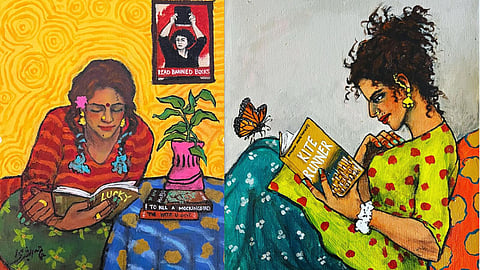
- HOMEGROWN WORLD
- #HGCREATORS
- #HGEXPLORE
- #HGVOICES
- #HGSHOP
- CAREERS
- ABOUT US
- CONTACT US

The following article focuses on a 'Banned Books Week' art series by Hamama Tul Bushra, a Pakistani artist renowned for her portrayals that explore women's empowerment, liberation, and emancipation
Banned Books Week, an annual event founded in 1982 by Judith Krug, a champion of the First Amendment and library activism, reminds us of the fundamental importance of untrammelled expression. Original works of art and literature often push boundaries in terms of subject matter, theme, plot, and structure. The digital age allows us unparalleled access to books that were once banned; granting us a window into the cultural landscape that surrounded their controversial prohibition.
Banned books frequently grapple with contemporary issues that resonate with readers, particularly young adults. They may encounter characters confronting similar challenges in their own lives; making the reading experience all the more impactful. These books can serve as a powerful tool for navigating complex issues like grief, divorce, sexual assault, bullying, prejudice, and sexual identity. They are also provide readers with a chance to discover the cultural and historical landscapes that gave rise to their eventual censorship.
Hamama Tul Bushra, a Pakistani artist renowned for her portrayals that explore women's empowerment, liberation, and emancipation, sheds light on this very topic through her art series, which she created for Banned Books Week. Her prints depict South Asian women relaxing in their homes, engrossed in famous banned books like Alice Walker's The Color Purple, George Orwell's 1984, J. D. Salinger's The Catcher in the Rye, Harper Lee's To Kill a Mockingbird, Anne Frank's Diary of a Young Girl, Khaled Hosseini's The Kite Runner, Madeleine L'Engle's A Wrinkle in Time, and more. These books, now iconic and often included in school curriculums, were once deemed too controversial for readers.
Bushra's artistic style is characterised by stylised figures that capture the essence and personality of her subjects. Cultural and traditional references and metaphors enrich her paintings, adding both depth and intrigue. By depicting South Asian women reading these banned books, Hamama makes a powerful statement about the significance of knowledge and the right to access information unrestricted.
With their unflinching exploration of taboo subjects and controversial themes, these books offer readers a mirror to society's collective conscience. They confront us with uncomfortable truths, challenge preconceived notions, and spark conversations that are as necessary as they are overdue. In this way, Hamama Tul Bushra's artwork serves as a timely reminder of the enduring importance of Banned Books Week.
You can follow Hamama here.
If you enjoyed reading this, here's more from Homegrown:
Hamama Tul Bushra's Evocative Art Is A Celebration Of Feminine Identity & Emancipation
Politics, Sex & Drugs – 9 Films That Were Banned In India
Key Cultural Moments That Sparked Nudity Controversies Across India
